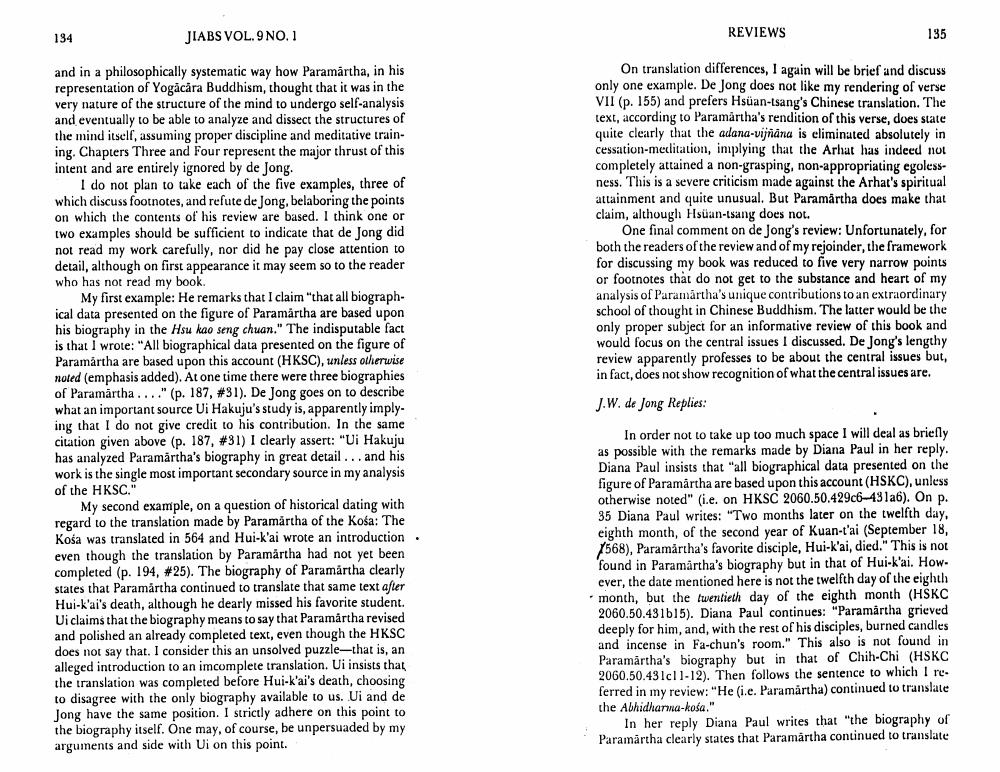________________
134
JIABS VOL. 9 NO.1
REVIEWS
135
On translation differences, I again will be brief and discuss only one example. De Jong does not like my rendering of verse VII (p. 155) and prefers Hsuan-tsang's Chinese translation. The text, according to Paramartha's rendition of this verse, does state quite clearly that the adana-vijñāna is eliminated absolutely in cessation-meditation, implying that the Arhat has indeed not completely attained a non-grasping, non-appropriating egolessness. This is a severe criticism made against the Arhat's spiritual attainment and quite unusual. But Paramartha does make that claim, although Hsuan-isang does not.
One final comment on de Jong's review: Unfortunately, for both the readers of the review and of my rejoinder, the framework for discussing my book was reduced to five very narrow points or footnotes that do not get to the substance and heart of my analysis of Paramartha's unique contributions to an extraordinary school of thought in Chinese Buddhism. The latter would be the only proper subject for an informative review of this book and would focus on the central issues I discussed. De Jong's lengthy review apparently professes to be about the central issues but, in fact, does not show recognition of what the central issues are.
and in a philosophically systematic way how Paramartha, in his representation of Yogācāra Buddhism, thought that it was in the very nature of the structure of the mind to undergo self-analysis and eventually to be able to analyze and dissect the structures of the mind itself, assuming proper discipline and meditative training. Chapters Three and Four represent the major thrust of this intent and are entirely ignored by de Jong.
I do not plan to take each of the five examples, three of which discuss footnotes, and refute de Jong, belaboring the points on which the contents of his review are based. I think one or two examples should be sufficient to indicate that de Jong did not read my work carefully, nor did he pay close attention to detail, although on first appearance it may seem so to the reader who has not read my book.
My first example: He remarks that I claim that all biographical data presented on the figure of Paramartha are based upon his biography in the Hsu kao seng chuan." The indisputable fact is that I wrote: "All biographical data presented on the figure of Paramartha are based upon this account (HKSC), unless otherwise noted (emphasis added). At one time there were three biographies of Paramartha...." (p. 187, #31). De Jong goes on to describe what an important source Ui Hakuju's study is, apparently implying that I do not give credit to his contribution. In the same citation given above (p. 187, #31) I clearly assert: "Ui Hakuju has analyzed Paramartha's biography in great detail ... and his work is the single most important secondary source in my analysis of the HKSC."
My second example, on a question of historical dating with regard to the translation made by Paramartha of the Kośa: The Koša was translated in 564 and Huik'ai wrote an introduction. even though the translation by Paramartha had not yet been completed (p. 194, #25). The biography of Paramartha clearly states that Paramartha continued to translate that same text after Hui-k'ai's death, although he dearly missed his favorite student. Ui claims that the biography means to say that Paramartha revised and polished an already completed text, even though the HKSC does not say that. I consider this an unsolved puzzle-that is, an alleged introduction to an imcomplete translation. Ui insists that the translation was completed before Hui-Kai's death, choosing to disagree with the only biography available to us. Ui and de Jong have the same position. I strictly adhere on this point to the biography itself. One may, of course, be unpersuaded by my arguments and side with Ui on this point.
J.W. de Jong Replies:
In order not to take up too much space I will deal as briefly as possible with the remarks made by Diana Paul in her reply. Diana Paul insists that all biographical data presented on the figure of Paramartha are based upon this account (HSKC), unless otherwise noted" (i.e. on HKSC 2060.50.429c6-431a6). On p. 35 Diana Paul writes: "Two months later on the twelfth day. eighth month, of the second year of Kuan-t'ai (September 18, 1568), Paramartha's favorite disciple, Hui-k'ai, died." This is not found in Paramartha's biography but in that of Hui-k'ai. However, the date mentioned here is not the twelfth day of the eighth month, but the twentieth day of the eighth month (HSKC 2060.50.431b15). Diana Paul continues: "Paramartha grieved deeply for him, and, with the rest of his disciples, burned candles and incense in Fa-chun's room." This also is not found in Paramartha's biography but in that of Chih-Chi (HSKC 2060.50.431cl l-12). Then follows the sentence to which I ruferred in my review: "He i.e. Paramartha) continued to translate the Abhidharma-kosa."
In her reply Diana Paul writes that "the biography of Paramartha clearly states that Paramartha continued to translate




